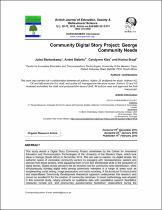| dc.identifier.citation | Stoltenkamp, J., Siebrits, A., Kies, C., & Braaf, N. (2015). Community Digital Story Project: George Community Needs. Journal of Education, Society and Behavioural Science, 7(1), 50-70. https://doi.org/10.9734/BJESBS/2015/15817 | en_US |
| dc.description.abstract | This study details a Digital Story Community Project undertaken by the Centre for Innovative
Education and Communication Technologies of the University of the Western Cape, which took
place in George (South Africa) in November 2014. The aim was to explore, via digital stories, the
authentic needs of vulnerable community sectors by engaging with representatives, leaders and
activists from those sectors, while equipping them in turn with transferable skills in the production of
digital stories. Digital stories proved to be an excellent tool for community need identification, while
simultaneously building digital skills among community members in a range of areas such as
storyboarding, script writing, image preparation, and voice recording. A Sociocultural Constructionist
and Asset-Based Community Development theoretical approach underpinned this research and
proved an excellent fit for the creation of community narratives. A mixed methodology was adopted
in this empirical study, relying primarily on qualitative data with quantitative support. Qualitative
measures include pre- and post-survey questionnaires, facilitators’ observations during the workshop, participant feedback within an online discussion forum, as well as the perceived impact
and application of digital stories. The skills attained, community needs and solutions produced, and
the potential contribution of ICTs in these are also discussed. Supporting quantitative measures are
drawn from an analysis of responses to the pre-and post-survey questionnaires and attendance
numbers during the workshop. Identified needs clustered around four interrelated themes: youth,
economic challenges, substance abuse, and healthcare. The use of digital stories in identifying
community needs, in a theoretically sound manner, is recommended in future research focusing on
community development. It is no longer possible or desirable to speak on behalf of communities in
relation to their development needs, and the digital story eTool is appropriate for obtaining authentic
community data, while building skills. | en_US |

